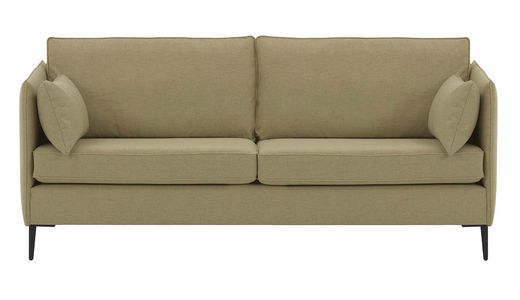
Japandi - a combination of Japanese and Scandinavian styles in interiors
The Japandi style is a fascinating fusion of Japanese and Scandinavian aesthetics that combines elegance, minimalism and functionality. This approach to interior design is characterised by simplicity, natural materials and harmonious details. Japandi-inspired interiors are ideal for those seeking calm, balance and modernity.
Minimalism and simplicity
Minimalism is at the heart of the Japandi style. Simple lines, muted colours and minimal decoration are key elements. When choosing furniture and accessories, go for pieces with a simple design that do not overwhelm the space. Less is more, so avoid excessive ornamentation and complicated patterns. Scandinavian simplicity blends perfectly with the Japanese philosophy of functionality to create a coherent and harmonious arrangement, in which every element has its place and purpose. The minimalist approach also allows to optically enlarge the space, which is especially important in smaller flats.
In addition, a space decorated in the Japandi style is conducive to tranquillity and relaxation, creating an environment conducive to contemplation and rest. The absence of superfluous elements helps to focus on what matters, both visually and in everyday life.
Natural materials
Natural materials are an integral part of the Japandi style. Wood, bamboo, wicker and linen dominate the style, giving the warmth and authenticity of the interior. Wooden furniture and accessories in natural tones fit perfectly with the Japandi philosophy, emphasising closeness to nature and simplicity of life. The Japanese aesthetic values naturalness and the nobility of raw materials, which is reflected in the choice of materials. Scandinavian inspirations, such as light pine wood, also add lightness and freshness to the arrangements.
Fabrics such as linen and cotton not only bring textural variety but also enhance the comfort of the interior. Accessories, such as bamboo curtains or hand-woven rugs, can add a personal touch and emphasise the uniqueness of the space.

Choosing furniture in the Japandi style
Furniture that combines simplicity of form with functionality and elegance plays a key role in the Japandi style. The Covex Wood 3 Seater Sofa is a versatile model that will work well in a classic living room as well as in modern or Scandinavian arrangements. The large, soft seat and back cushions provide exceptional comfort, while the velour fabric it is covered with adds elegance and character to the furniture. The Nist 2 Seater Sofa, on the other hand, inspired by Scandinavian style, is distinguished by its simple elegance and comfort. Its functionality and subtle design make it an adornment of any living room or guest room, giving the space a cosy and warm character. Both models fit perfectly into the Japandi philosophy, combining aesthetics with comfort.
Colour scheme
The colour scheme in the Japandi style is subdued and harmonious, which promotes tranquillity and brings a sense of balance to the interior. Neutral colours such as white, grey, beige and warm wood tones are typical of this style. Earthy colours, such as brown or olive, can also be used to add cosiness and elegance to the interior. It is also worth introducing subtle accents in the form of darker colours, such as graphite or black, to give depth and sophistication.
A colour palette inspired by nature, shades of wood, sand or stone, helps to create an atmosphere of calm and order. This makes Japandi-style interiors perfect for both everyday living and relaxing after a busy day.
Patterns and decorations
The patterns and decorations in the Japandi style are subtle and elegant, which emphasises the minimalist nature of the arrangement. Japanese motifs such as cherry blossoms, bamboo or geometric patterns, combined with Scandinavian accents, create a unique aesthetic. It is advisable to choose handmade items such as ceramics or textiles in neutral tones, which act as decorative without overwhelming the space.
Decorations can also draw on the Wabi-Sabi philosophy of appreciating beauty in imperfection. Fine ceramics with visible traces of handmade workmanship or a patinated surface are enough to bring a touch of authenticity to the interior.

Furniture and lighting
Japandi-style furniture combines functionality with aesthetics. Low, minimalist furniture made from natural materials fits perfectly into this style. Choose simple forms that do not overwhelm the space, yet offer comfort and utility. Solid wood tables, low-profile sofas and lightweight chairs are staples of the Japandi interior.
Lighting should be subtle and warm to create an atmosphere of calm and harmony. Lamps made from natural materials such as paper, bamboo or wood can add Japanese charm to the interior. Spotlighting, such as delicate lanterns or LED strips, can highlight selected design elements while creating a cosy atmosphere.
Summary
Japandi-inspired interiors combine the elegance of Japanese minimalism with the functionality of Scandinavian design. The key elements of this style are simplicity, natural materials, muted colours and subtle patterns. The Japandi style is ideal for those who want to create a space that exudes calm, balance and modernity while valuing timeless aesthetics and practicality. By harmoniously combining the Japanese philosophy of Wabi-Sabi and Scandinavian Hygge, Japandi-style interiors become a place that soothes the senses and promotes regeneration of vitality.











